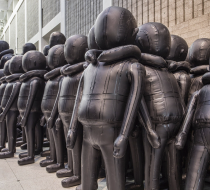Law of the Journey Favorite
The exhibition Law of the Journey is Ai Weiwei’s multi-layered, epic statement on the human condition: an artist’s expression of empathy and moral concern in the face of continuous, uncontrolled destruction and carnage. Hosted in a building of symbolic historical charge – a former 1928 Trade Fair Palace which in 1939–1941 served as an assembly point for Jews before their deportation to the concentration camp in Terezín – it works as a site-specific parable, a form of (public) speech, carrying a transgressive power of cathartic experience, but also a rhetoric of failure, paradox and resignation. Like Noah’s Ark, a monumental rubber boat is a contemporary vessel of forced exodus, floating hopelessly within the immense, oceanic abyss of the Gallery’s post-industrial, cathedral-like Big Hall. Set for a journey across the unknown and the infinite, an overcrowded life raft carries ‘the vanguard of their people’, as Hannah Arendt described the illegal and the stateless in her seminal 1943 essay, We Refugees: over 300 figures, squeezed within the confines of a temporary shelter, undertake a journey ‘far out into the unnavigated’, fleeing violence and danger.








